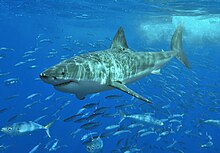板鳃亚纲
板鳃亚纲(学名:Elasmobranchii)属于软骨鱼纲,包括鲨鱼和鳐。鱼鳃是板状,鳃裂 5-7 对,鳃间隔宽大。体外是盾鳞或光滑,雄性腹鳍转化为鳍足,没有鱼鳔,仰赖富含油脂的鱼肝维持浮力。
| 板鳃亚纲 化石时期:
| |
|---|---|

| |
| 大白鲨 | |
| 科学分类 | |
| 界: | 动物界 Animalia |
| 门: | 脊索动物门 Chordata |
| 纲: | 软骨鱼纲 Chondrichthyes |
| 亚纲: | 板鳃亚纲 Elasmobranchii Bonaparte, 1838 |
| 目 | |
| |
最早的板鳃亚纲公认化石发现于志留纪,现存大部分的目多在侏罗纪之后出现。许多早期种类在二叠纪末期中绝种,也因此导致在侏罗纪时发生辐射适应。
描述
编辑板鳃亚纲为软骨鱼纲下的两个亚纲之一,另一个为全头亚纲(银鲛)。鳃裂 5-7 对,体外是盾鳞,没有鱼鳔,眼睛具有脉络膜层,雄性腹鳍特化为鳍足。板鳃亚纲遍布于热带与温带的水域中[2]。
许多鱼类仰赖鱼鳔维持浮力,但没有鱼鳔的板鳃亚纲物种则透过富含油脂的鱼肝来维持浮力[3]。这些油脂在食物短少时也能作为暂时的营养来源[4][5]。其中深海鲨鱼的肝重量可达体重 20%[6],常被视为是渔业捕获的目标。
演化历程
编辑目前最早已知确认属于板鳃亚纲总群的演化支为亮齿鲨属,生存于约3.83亿年前的中泥盆纪(晚吉维特期)时期[7]。其他较著名的板鳃亚纲总群演化支,如栉棘鲨目与弓鲨目,则是于晚泥盆纪(法门期)出现[8]。
石炭纪时期,部分栉棘鲨目物种体长已可达7米(23英尺),与现存的大白鲨相当[9]。在石炭纪及二叠纪时期,异刺鲨目同时活跃于淡水及海洋生态系,直到三叠纪物种多样性才逐渐递减[10]。弓鲨目在二叠纪时期具有十分高的物种丰富度[11],且直到三叠纪至早侏罗纪时期前都是由弓鲨目占了板鳃亚纲物种的大多数,牠们同样也同时活跃于淡水及海洋生态系中[12]。
三叠纪时期,狭义的板鳃亚纲(新鲨类,包含了现存的鲨总目及鳐总目)出现,但牠们一直到早侏罗纪才逐渐多样化,现存的鲨鱼及鳐鱼演化支也大多是于此时出现[13]。与此相反的是,弓鲨目的物种丰富度却是随着时间递减,直到晚侏罗纪时,在海洋中已几乎不存在弓鲨目的物种,但牠们于淡水环境中直到白垩纪时期仍十分常见[14],目前已知最后的弓鲨目物种存到了白垩纪晚期[15]。
分类
编辑本亚纲现存种类主要有两大类:鲨类和鳐类,分为如下各目:
包括已灭绝种类的分类:
- †Plesioselachus
- †似扁鲨目 Squatinactiformes
- †原尖齿鲨目 Protacrodontiformes
- †异棘鲨总目 Xenacanthimorpha
- †异棘鲨目 Xenacanthiformes
- 鲨鳐下纲 Euselachii
其他:
- † Aellopobatis 属
- Aellopobatis bavarica Türtscher, Jambura, Villalobos-Segura, López-Romero, Underwood, Thies, Lauer, Lauer & Kriwet, 2024[16]
参考文献
编辑- ^ Märss, Tiiu; Gagnier, Pierre-Yves. A new chondrichthyan from the Wenlock, Lower Silurian, of Baillie-Hamilton Island, the Canadian Arctic. Journal of Vertebrate Paleontology. 2001, 21 (4): 693–701. doi:10.1671/0272-4634(2001)021[0693:ANCFTW]2.0.CO;2.
- ^ Bigelow, Henry B.; Schroeder, William C. Fishes of the Western North Atlantic. Sears Foundation for Marine Research, Yale University. 1948: 64–65. ASIN B000J0D9X6.
- ^ Oguri, M (1990) "A review of selected physiological characteristics unique to elasmobranchs" (页面存档备份,存于互联网档案馆) In: Elasmobranchs as living resources: advances in the biology, ecology, systematics and the status of the fisheries, eds. J. H. L. Pratt, S. H. Gruber and T. Taniuchi, US Department of Commerce, NOAA technical report NMFS 90, pp.49–54.
- ^ Hoenig, J.M. and Gruber, S.H. (1990) "Life-history patterns in the elasmobranchs: implications for fisheries management" (页面存档备份,存于互联网档案馆) In: Elasmobranchs as living resources: advances in the biology, ecology, systematics and the status of the fisheries, eds. J. H. L. Pratt, S. H. Gruber and T. Taniuchi, US Department of Commerce, NOAA technical report NMFS 90, pp.1–16.
- ^ Bone, Q.; Roberts, B. L. The density of elasmobranchs. Journal of the Marine Biological Association of the United Kingdom. 2009, 49 (4): 913. doi:10.1017/S0025315400038017.
- ^ Vannuccini, Stefania (2002) Shark liver oil products (页面存档备份,存于互联网档案馆) In: Shark Utilization, Marketing and Trade, Fisheries Technical paper 389, FAO, Rome. ISBN 92-5-104361-2.
- ^ Frey, Linda; Coates, Michael; Ginter, Michał; Hairapetian, Vachik; Rücklin, Martin; Jerjen, Iwan; Klug, Christian. The early elasmobranch Phoebodus : phylogenetic relationships, ecomorphology and a new time-scale for shark evolution. Proceedings of the Royal Society B: Biological Sciences. 2019-10-09, 286 (1912): 20191336. ISSN 0962-8452. PMC 6790773 . PMID 31575362. doi:10.1098/rspb.2019.1336 (英语).
- ^ Schultze, H.-P., Bullecks, J., Soar, L. K., & Hagadorn, J. (2021). Devonian fish from Colorado’s Dyer Formation and the appearance of Carboniferous faunas in the Famennian. In A. Pradel, J. S. S. Denton, & P. Janvier (Eds.), Ancient Fishes and their Living Relatives: a Tribute to John G. Maisey (pp. 247–256.). Verlag Dr. Friedrich Pfeil.
- ^ Maisey, John G.; Bronson, Allison W.; Williams, Robert R.; McKinzie, Mark. A Pennsylvanian 'supershark' from Texas. Journal of Vertebrate Paleontology. 2017-05-04, 37 (3): e1325369. Bibcode:2017JVPal..37E5369M. ISSN 0272-4634. S2CID 134127771. doi:10.1080/02724634.2017.1325369 (英语).
- ^ Pauliv, Victor E.; Martinelli, Agustín G.; Francischini, Heitor; Dentzien-Dias, Paula; Soares, Marina B.; Schultz, Cesar L.; Ribeiro, Ana M. The first Western Gondwanan species of Triodus Jordan 1849: A new Xenacanthiformes (Chondrichthyes) from the late Paleozoic of Southern Brazil. Journal of South American Earth Sciences. December 2017, 80: 482–493. Bibcode:2017JSAES..80..482P. doi:10.1016/j.jsames.2017.09.007 (英语).
- ^ Koot, Martha B.; Cuny, Gilles; Tintori, Andrea; Twitchett, Richard J. A new diverse shark fauna from the Wordian (Middle Permian) Khuff Formation in the interior Haushi-Huqf area, Sultanate of Oman. Palaeontology. March 2013, 56 (2): 303–343. Bibcode:2013Palgy..56..303K. ISSN 0031-0239. S2CID 86428264. doi:10.1111/j.1475-4983.2012.01199.x (英语).
- ^ Rees, J. A. N., and Underwood, C. J., 2008, Hybodont sharks of the English Bathonian and Callovian (Middle Jurassic): Palaeontology, v. 51, no. 1, p. 117-147.
- ^ Underwood, Charlie J. Diversification of the Neoselachii (Chondrichthyes) during the Jurassic and Cretaceous. Paleobiology. March 2006, 32 (2): 215–235. Bibcode:2006Pbio...32..215U. ISSN 0094-8373. S2CID 86232401. doi:10.1666/04069.1 (英语).
- ^ Rees, Jan; Underwood, Charlie J. Hybodont Sharks of the English Bathonian and Callovian (Middle Jurassic). Palaeontology. January 2008, 51 (1): 117–147. Bibcode:2008Palgy..51..117R. ISSN 0031-0239. doi:10.1111/j.1475-4983.2007.00737.x (英语).
- ^ Carrillo-Briceño, Jorge D.; Cadena, Edwin A.; Dececchi, Alex T.; Larson, Hans C. E.; Du, Trina Y. First record of a hybodont shark (Chondrichthyes: Hybodontiformes) from the Lower Cretaceous of Colombia. Neotropical Biodiversity. 2016-01-01, 2 (1): 81–86. Bibcode:2016NeBio...2...81C. ISSN 2376-6808. doi:10.1080/23766808.2016.1191749 (英语).
- ^ Julia Türtscher, Patrick L. Jambura, Eduardo Villalobos-Segura, Faviel A. López-Romero, Charlie J. Underwood, Detlev Thies, Bruce Lauer, René Lauer and Jürgen Kriwet. 2024. Rostral and Body Shape Analyses reveal Cryptic Diversity of Late Jurassic batomorphs (Chondrichthyes, Elasmobranchii) from Europe. Papers in Palaeontology. DOI: 10.1002/spp2.1552